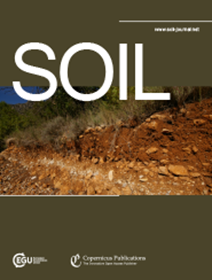利用在线土壤硝酸盐数据优化施肥
IF 5.8
2区 农林科学
Q1 SOIL SCIENCE
引用次数: 0
摘要
摘要安装在耕地中的新型土壤硝酸盐监测系统使我们首次能够控制整个土壤剖面的硝酸盐浓度。该监测系统安装在一个用于种植甜椒作物的大型农业温室中。在两个地块的土壤剖面上对土壤硝酸盐浓度进行了连续测量:(a) 调整施肥地块,根据土壤硝酸盐浓度的动态变化经常调整施肥制度;(b) 对照地块,根据预定的施肥计划进行施肥管理,该计划是该地区的标准做法。研究结果实现了以小时为单位跟踪土壤硝酸盐浓度随每天施肥量和作物需求量的动态变化。对照地块根区及以下的硝态氮(N-NO3)浓度在整个季节都达到了 180 ppm 以上的高水平。显然,这一浓度反映了施肥过量,远远超出了植物的需求,可能会造成严重的地下水污染。另一方面,在调整后的施肥地块上经常调整施肥制度,可以将土壤硝酸盐浓度控制在所需浓度阈值附近。这使得施肥量大幅减少了 38%,同时保持了最高的作物产量和质量。在整个实验过程中,施肥调整的决策都是通过人工目测土壤对施肥制度变化的反应来完成的。然而,显而易见的是,在整个土壤剖面上持续处理土壤硝酸盐浓度并提供直接施肥指令的算法可以充当 "施肥器",将土壤养分设定在所需的最佳水平。因此,可以得出这样的结论:基于对土壤硝酸盐浓度的持续监测进行施肥,可以确保养分的施用考虑到植物的需求,提高农业收益率,最大限度地减少硝酸盐下渗,并显著减少水资源污染。本文章由计算机程序翻译,如有差异,请以英文原文为准。
Optimized fertilization using online soil nitrate data
Abstract. A new soil nitrate monitoring system that was installed in a cultivated field enabled us, for the first time, to control the nitrate concentration across the soil profile. The monitoring system was installed in a full-scale agricultural greenhouse setup that was used for growing a bell pepper crop. Continuous measurements of soil nitrate concentrations were performed across the soil profile of two plots: (a) an adjusted fertigation plot, in which the fertigation regime was frequently adjusted according to the dynamic variations in soil nitrate concentration, and (b) a control plot, in which the fertigation was managed according to a predetermined fertigation schedule that is standard practice for the area. The results enabled an hourly resolution in tracking the dynamic soil nitrate concentration variations in response to daily fertigation and crop demand. Nitrate–nitrogen (N–NO3) concentrations in and below the root zone, under the control plot, reached very high levels of ∼ 180 ppm throughout the entire season. Obviously, this concentration reflects excessive fertigation, which is far beyond the plant demand, entailing severe groundwater pollution potential. On the other hand, frequent adjustments of the fertigation regime, which were carried out under the adjusted fertigation plot, enabled control of the soil nitrate concentration around the desired concentration threshold. This enabled a substantial reduction of 38 % in fertilizer application while maintaining maximum crop yield and quality. Throughout this experiment, decision-making on the fertigation adjustments was done manually based on visual inspections of the soil's reactions to changes in the fertigation regime. Nevertheless, it is obvious that an algorithm that continuously processes the soil nitrate concentration across the soil profile and provides direct fertigation commands could act as a “fertistat” that sets the soil nutrients at a desired optimal level. Consequently, it is concluded that fertigation that is based on continuous monitoring of the soil nitrate concentration may ensure nutrient application that accounts for plant demand, improves agricultural profitability, minimizes nitrate down-leaching and significantly reduces water resource pollution.
求助全文
通过发布文献求助,成功后即可免费获取论文全文。
去求助
来源期刊

Soil
Agricultural and Biological Sciences-Soil Science
CiteScore
10.80
自引率
2.90%
发文量
44
审稿时长
30 weeks
期刊介绍:
SOIL is an international scientific journal dedicated to the publication and discussion of high-quality research in the field of soil system sciences.
SOIL is at the interface between the atmosphere, lithosphere, hydrosphere, and biosphere. SOIL publishes scientific research that contributes to understanding the soil system and its interaction with humans and the entire Earth system. The scope of the journal includes all topics that fall within the study of soil science as a discipline, with an emphasis on studies that integrate soil science with other sciences (hydrology, agronomy, socio-economics, health sciences, atmospheric sciences, etc.).
 求助内容:
求助内容: 应助结果提醒方式:
应助结果提醒方式:


